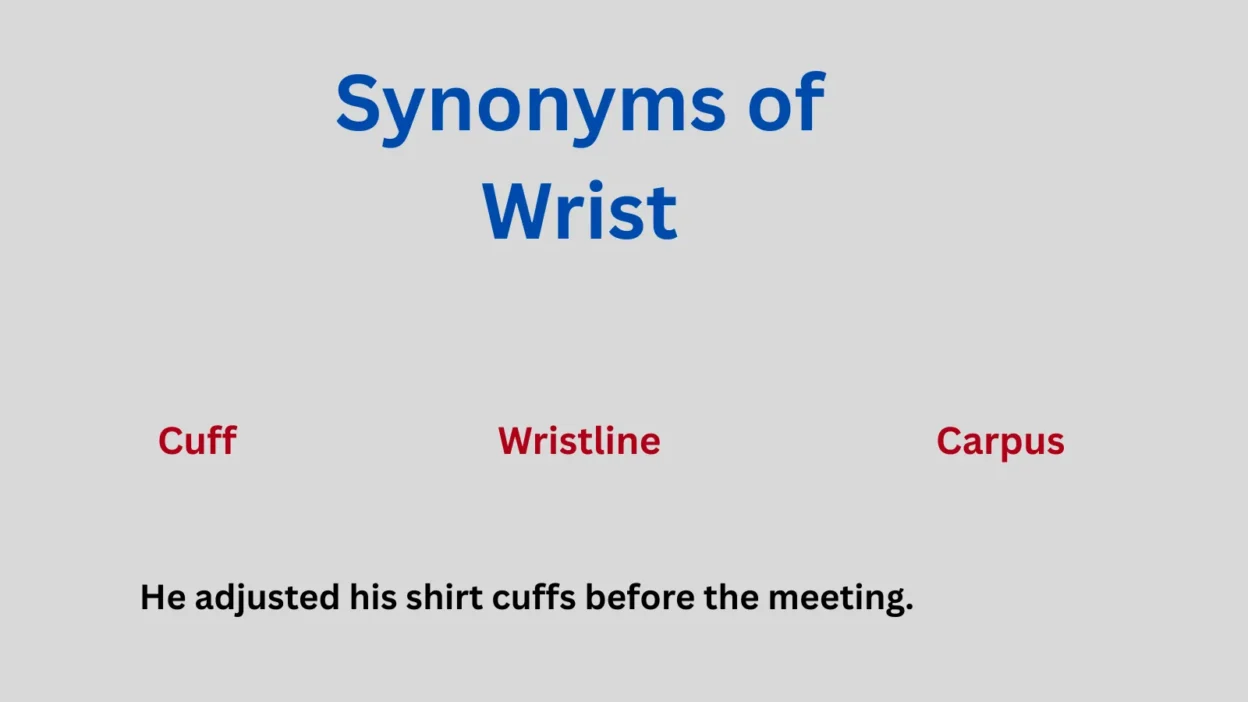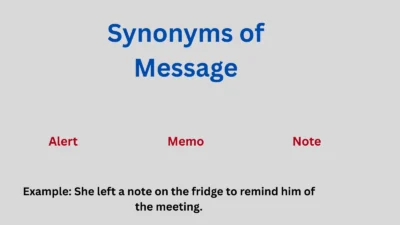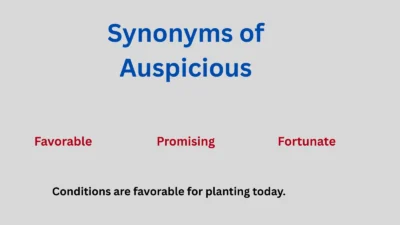Synonyms of wrist, such as carpus and wrist joint, offer more precise ways to describe this important part of the body, especially in medical, anatomical, or technical contexts. If you’re studying human anatomy, writing a health article, or explaining a yoga pose, the word you choose can impact clarity and professionalism.
Picture a physical therapist giving instructions: saying “rotate your wrist joint” sounds more precise and credible than just “move your wrist.” That small choice of words makes a big difference in tone and understanding.
In this guide, we’ll explore the most relevant and accurate synonyms of wrist, explain when to use them, and provide example sentences so you can confidently apply them in both casual and formal situations.
30 Synonyms and Related Words for Wrist
1. Wrist Joint
Meaning: The actual joint where the hand and forearm connect.
Use it when: Describing the anatomy or medical aspect precisely.
- The injury was isolated to the wrist joint.
- Flexibility in the wrist joint is key for playing piano.
2. Carpus
Meaning: The anatomical name for the group of bones forming the wrist.
Use it when: Writing medically or scientifically.
- The fracture was located in the carpus.
- She studied the structure of the carpus in anatomy class.
3. Wristline
Meaning: The line or area around the wrist, especially in fashion.
Use it when: Talking about clothing, design, or fit.
- The blouse ends right at the wristline.
- The bracelet hugged her wristline perfectly.
4. Cuff
Meaning: The end of a sleeve that encircles the wrist.
Use it when: Referring to garments or style.
- He adjusted his shirt cuffs before the meeting.
- The jacket had wide, dramatic cuffs.
5. Lower Arm
Meaning: A general term for the area between the elbow and the wrist.
Use it when: Being intentionally vague or less clinical.
- She wore a tattoo on her lower arm, near the wrist.
- The pain traveled up the lower arm.
6. Forearm
Meaning: The part of the arm between the elbow and the wrist.
Use it when: Describing movement, strength, or posture.
- He gripped the bar with tense forearms.
- The exercise targets the forearms and wrists.
7. Base of the Hand
Meaning: The spot where the hand meets the wrist.
Use it when: Highlighting hand movement or gesture.
- He felt a sharp pain at the base of the hand.
- She applied pressure at the base of the hand.
8. Joint
Meaning: A general term for where two bones meet.
Use it when: Being broad or referencing pain/mobility.
- The joint swelled after the fall.
- He has arthritis in several joints, including the wrist.
9. Articulation
Meaning: The connection between bones allows movement.
Use it when: Writing academically or in a detailed medical context.
- The wrist’s articulation allows complex motion.
- Damage to the articulation can reduce mobility.
10. Radial Side
Meaning: The thumb-side of the wrist/forearm.
Use it when: Being anatomically specific.
- The pain was localized to the radial side.
- The radial side showed swelling.
11. Ulnar Side
Meaning: The pinky side of the wrist.
Use it when: Giving precise anatomical direction.
- Tingling on the ulnar side can indicate nerve issues.
- The break occurred near the ulnar side of the wrist.
12. Flexor Area
Meaning: The inside of the wrist, where the hand flexes.
Use it when: Talking about muscle or movement.
- The strain was in the flexor area.
- He wore a brace over the flexor area.
13. Wrist Bone
Meaning: Informal reference to any of the carpal bones.
Use it when: Writing casually or when being non-specific.
- I think I cracked a wrist bone.
- The wrist bone stuck out awkwardly.
14. Wristband Area
Meaning: Where watches or bracelets typically rest.
Use it when: Describing fit, style, or wearables.
- The smart watch fits snugly around the wristband area.
- He had tan lines on his wristband area.
15. Hand Joint
Meaning: Casual term linking wrist and hand.
Use it when: Generalizing movement or pain.
- The hand joint hurt when he lifted the box.
- He rubbed the hand joint absentmindedly.
16. Watch Point
Meaning: The specific spot where a watch is worn.
Use it when: Discussing style, design, or wearables.
- The watch point needs to be comfortable for daily wear.
- He adjusted the strap to fit his watch point.
17. Band Area
Meaning: Refers to the spot where a band (e.g. fitness tracker) is worn.
Use it when: Talking about smart devices or accessories.
- The band area was red from chafing.
- She tightened the strap on the band area.
18. Brace Zone
Meaning: Where a wrist brace is typically applied.
Use it when: Describing protective or medical gear.
- The brace zone must stay immobilized.
- Doctors applied pressure to the brace zone.
19. Pulse Point
Meaning: The spot where you feel the radial artery.
Use it when: Referring to checking the heartbeat or emotion.
- He placed two fingers on her pulse point.
- The perfume was dabbed gently on the pulse point.
20. Hinge
Meaning: Figurative reference to wrist movement.
Use it when: Describing motion in poetic or metaphorical terms.
- Her wrist moved like a smooth hinge.
- The hinge of his arm snapped in a punch.
21. Connector
Meaning: Emphasizing the wrist as a link between the hand and arm.
Use it when: Describing a function or structure.
- The connector between the hand and the arm is delicate.
- Damage to the connector limited motion.
22. Joint Link
Meaning: The mechanical point of connection.
Use it when: Using metaphor in robotics or bio-mechanics.
- The robot’s joint link mimics the human wrist.
- The joint link must be strong yet flexible.
23. Wrist Area
Meaning: Broad term for the general zone.
Use it when: Being imprecise on purpose.
- Pain in the wrist area persisted for days.
- A tattoo covered her entire wrist area.
24. Glove Line
Meaning: Where a glove ends on the wrist.
Use it when: Discussing fashion or design.
- The gloves ended at the glove line, with a perfect fit.
- Lace trimmed the glove line delicately.
25. Wrist Surface
Meaning: The outer skin of the wrist.
Use it when: Describing touch or appearance.
- The watch left a mark on the wrist surface.
- She brushed the wrist surface gently.
26. Inner Wrist
Meaning: The softer underside of the wrist.
Use it when: Describing vulnerability, tenderness, or emotion.
- She wrote a note on her inner wrist.
- The inner wrist is often used for checking a pulse.
27. Outer Wrist
Meaning: The top or back side of the wrist.
Use it when: Contrasting with the inner wrist.
- The tattoo sat on his outer wrist.
- He bruised his outer wrist in the fall.
28. Wrist Bend
Meaning: Describes the curved angle of the wrist.
Use it when: Talking about motion or posture.
- A sharp wrist bend can cause strain.
- Her wrist bend was graceful and fluid.
29. Support Point
Meaning: Where the wrist bears weight or strain.
Use it when: Talking about lifting or athletic activity.
- Your support point must stay stable during push-ups.
- The support point collapsed under pressure.
30. Bracelet Zone
Meaning: The place where bracelets are typically worn.
Use it when: Writing about fashion or jewelry.
- She stacked silver bangles along her bracelet zone.
- The bracelet zone caught the candlelight beautifully.
How to Choose the Right Synonym for Wrist
✅ Be Technical for Clarity
Use words like carpus, articulation, or radial side when writing medical, anatomical, or sports-related content.
✅ Be Stylistic for Creativity
Use bracelet zone, glove line, or pulse point for fashion, storytelling, or poetic writing.
✅ Be Broad When Needed
Use the wrist area, connector, or support point when you want a general reference without being too specific.
Final Thoughts:
Understanding the synonyms of wrist, such as carpus, wrist joint, and other anatomical terms, allows for more precise and professional communication, especially in medical, fitness, or scientific contexts. While wrist is the commonly used term, its alternatives offer clarity and accuracy when the situation calls for it.
By learning these variations, you expand your ability to describe the human body in detail, if you’re writing a health article, giving instructions, or studying anatomy.
Each synonym brings its level of formality and specificity, helping you adapt your language to suit your audience.



